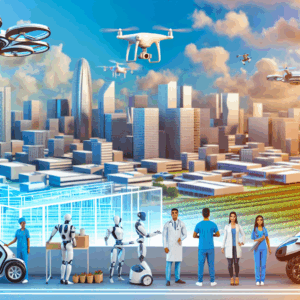A Basic Understanding of Transformers: Unlocking the Future of AI
Transformers have revolutionized the field of machine learning, particularly in natural language processing (NLP), by providing a powerful alternative to traditional recurrent neural networks (RNNs) and convolutional neural networks (CNNs). This blog post aims to provide a foundational understanding of transformers, including their architecture, how they work, their advantages over traditional models, and their applications in various domains.
I. Introduction
In recent years, transformers have become a cornerstone of AI research and development, especially with the emergence of models like BERT and GPT. Understanding transformers is crucial for anyone interested in machine learning and AI, as they have significantly improved the performance of tasks such as machine translation, text summarization, and sentiment analysis. This blog will cover the basics of transformers, their architecture, their working mechanism, and their applications.
II. What are Transformers?
Transformers were first introduced in the paper “Attention Is All You Need” by Vaswani et al. in 2017. This innovation marked a significant shift from traditional sequence-to-sequence models that relied heavily on RNNs or CNNs. Transformers are primarily designed for handling sequential data, such as text, and they excel at capturing long-range dependencies within sequences.
Historical Context
The development of transformers was a response to the limitations of RNNs, which struggled with parallelization and handling long sequences efficiently. By leveraging self-attention mechanisms, transformers can process input sequences in parallel, making them much faster and more efficient than RNNs for many tasks.
III. The Architecture of Transformers
The transformer architecture consists of two main components: the encoder and the decoder. Both components are composed of identical layers, each of which includes two sub-layers: a self-attention mechanism and a feed-forward neural network (FFNN). Additionally, the encoder and decoder layers include a layer normalization step and a residual connection around each sub-layer.
Components of Transformer Architecture
- Self-Attention Mechanism: This is the core innovation of transformers, allowing them to weigh the importance of different input elements relative to each other.
- Feed-Forward Networks (FFNNs): These are used to transform the output from the self-attention mechanism.
- Positional Encoding: Since transformers do not inherently capture sequence order, positional encoding is added to the input embeddings to preserve the sequence information.
[Infographic: Transformer Architecture]
IV. How Transformers Work
The self-attention mechanism is what sets transformers apart from other neural network architectures. It allows the model to attend to all positions in the input sequence simultaneously and weigh their importance.
Self-Attention Mechanism
The self-attention mechanism involves three vectors derived from the input sequence:
- Query (Q): Represents the context in which the attention is being applied.
- Key (K): Used to compute the attention weights.
- Value (V): Used to compute the weighted sum.
The attention weights are computed as the dot product of Q and K divided by the square root of the key’s dimensionality. These weights are then used to compute a weighted sum of V.
Multi-Head Attention
Transformers use multi-head attention, which allows the model to jointly attend to information from different representation subspaces at different positions. This is achieved by applying multiple attention mechanisms in parallel and then concatenating their outputs.
Code Example: Simple Transformer Implementation
Here’s a simplified example of a transformer layer implemented in PyTorch:
import torch
import torch.nn as nn
import torch.nn.functional as F
class SelfAttention(nn.Module):
def __init__(self, embed_dim, num_heads):
super(SelfAttention, self).__init__()
self.embed_dim = embed_dim
self.num_heads = num_heads
self.head_dim = embed_dim // num_heads
self.query_linear = nn.Linear(embed_dim, embed_dim)
self.key_linear = nn.Linear(embed_dim, embed_dim)
self.value_linear = nn.Linear(embed_dim, embed_dim)
def forward(self, x):
# Get batch size and sequence length
batch_size, seq_len, embed_dim = x.size()
# Compute Q, K, V
q = self.query_linear(x).view(batch_size, -1, self.num_heads, self.head_dim).transpose(1, 2)
k = self.key_linear(x).view(batch_size, -1, self.num_heads, self.head_dim).transpose(1, 2)
v = self.value_linear(x).view(batch_size, -1, self.num_heads, self.head_dim).transpose(1, 2)
# Compute attention scores
attention_scores = torch.matmul(q, k.transpose(-1, -2)) / math.sqrt(self.head_dim)
# Compute attention weights
attention_weights = F.softmax(attention_scores, dim=-1)
# Compute weighted sum
output = torch.matmul(attention_weights, v).transpose(1, 2).reshape(batch_size, seq_len, embed_dim)
return output
class TransformerLayer(nn.Module):
def __init__(self, embed_dim, num_heads):
super(TransformerLayer, self).__init__()
self.self_attention = SelfAttention(embed_dim, num_heads)
self.feed_forward = nn.Linear(embed_dim, embed_dim)
def forward(self, x):
x = self.self_attention(x)
x = self.feed_forward(x)
return x
# Example usage
transformer_layer = TransformerLayer(embed_dim=512, num_heads=8)
input_tensor = torch.randn(1, 10, 512) # Example input tensor
output = transformer_layer(input_tensor)
V. Advantages of Transformers Over Traditional Models
Transformers offer several advantages over RNNs and CNNs:
- Parallelization: Unlike RNNs, which process sequences sequentially, transformers can process input sequences in parallel, making them much faster for large datasets.
- Handling Long-Range Dependencies: Transformers are particularly adept at capturing long-range dependencies within sequences, which is crucial for tasks like machine translation.
- Scalability: Transformers can handle longer sequences and larger models more efficiently than RNNs.
VI. Applications of Transformers
Transformers have found widespread applications in NLP tasks such as:
- Machine Translation: Transformers have significantly improved the accuracy of machine translation tasks by better capturing context and long-range dependencies.
- Text Summarization: They are used to generate summaries that capture the essence of long documents.
- Sentiment Analysis: Transformers can analyze sentiment more accurately by considering the entire context of a sentence.
Beyond NLP, transformers are being explored in other domains like:
- Computer Vision: Transformers are being used in vision tasks, such as image classification and object detection, through models like Vision Transformers (ViT).
- Reinforcement Learning: They are being applied to improve decision-making in complex environments.
VII. The Future of Transformer Models
As AI continues to evolve, transformers are likely to remain at the forefront of innovation. Emerging trends include:
- Efficient Transformers: Research is focused on making transformers more efficient and scalable for real-world applications.
- Multimodal Transformers: These models aim to integrate information from different modalities (e.g., text, images, audio) to create more comprehensive AI systems.
However, challenges such as computational cost and interpretability remain. Addressing these challenges will be crucial for the future development of transformer models.
VIII. Conclusion
Transformers have revolutionized the field of machine learning, particularly in NLP, by offering a powerful alternative to traditional models. Their ability to capture long-range dependencies and process sequences in parallel has made them indispensable for tasks like machine translation and text summarization. As AI continues to evolve, understanding transformers will remain essential for anyone interested in machine learning and AI.
For further reading on transformers and their applications, you can explore the following resources:
- “Attention Is All You Need” by Vaswani et al. (2017): This seminal paper introduced the transformer architecture and its self-attention mechanism. Available online
- BERT and GPT Models: These models are examples of how transformers are used in real-world applications for NLP tasks. You can find more information about these models through various online resources and research papers.
By delving deeper into these resources, you can gain a more comprehensive understanding of transformers and their role in shaping the future of AI.





